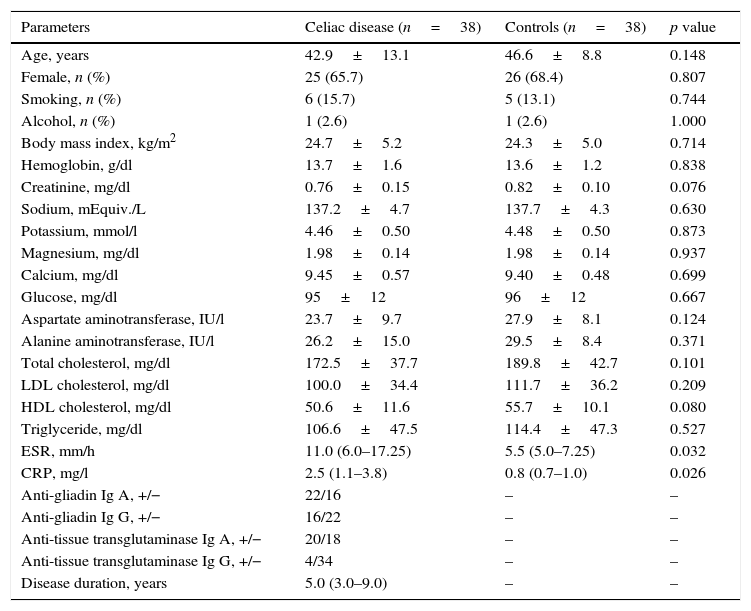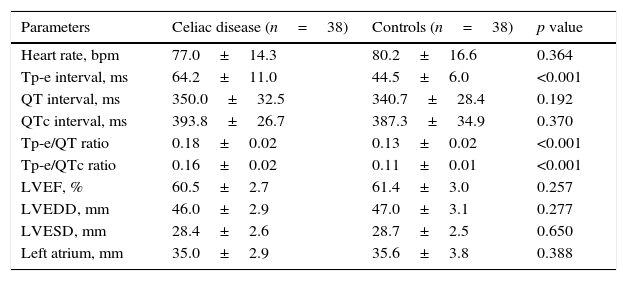Celiac disease is a chronic immune-mediated disease of the small intestine. It has been known that dilated cardiomyopathy and ischemic coronary artery disease have become more frequent in patients with celiac disease. The aim of the study was to assess Tp-e interval and Tp-e/QT ratio in patients with celiac disease.
Material and methodsThis study was conducted at a single center in collaboration with gastroenterology and cardiology clinics. Between January 2014 and June 2015, a total of 76 consecutive patients were enrolled (38 patients with celiac disease and 38 control subjects). Tp-e interval, Tp-e/QT and Tp-e/QTc ratio were measured from the 12-lead electrocardiogram.
ResultsTp-e interval (64.2±11.0 vs. 44.5±6.0; p<0.001), Tp-e/QT ratio (0.18±0.02 vs. 0.13±0.02; p<0.001) and Tp-e/QTc ratio (0.16±0.02 vs. 0.11±0.01; p<0.001) were significantly higher in patients with celiac disease than control subjects. There was a significant positive correlation between Tp-e/QTc ratio and disease duration in patients with celiac disease (r=0.480, p=0.003) and also there was a significant positive correlation between Tp-e/QTc ratio and erythrocyte sedimentation rate (r=0.434, p<0.001).
ConclusionsOur study showed that Tp-e interval, Tp-e/QT and Tp-e/QTc ratios were increased in patients with celiac disease. Whether these changes increase the risk of ventricular arrhythmia deserve further studies.
La enfermedad celíaca (EC) o celiaquía, es una enfermedad crónica del intestino delgado inmuno-mediada. Es bien sabido que la cardiomiopatía dilatada y la cardiopatía isquémica se han hecho frecuentes en los pacientes celíacos. El objetivo de este estudio fue evaluar el intervalo Tp-e y el ratio Tp-e/QT ratio en los pacientes con celiaquía.
Material y métodosEste estudio se realizó en un único centro, en colaboración con los clínicos de gastroenterología y cardiología. Entre enero de 2014 y junio de 2015 se incluyeron a un total de 76 pacientes consecutivos (38 pacientes con celiaquía y 38 sujetos control). Se midieron el intervalo Tp-e y los ratios Tp-e/QT y Tp-e/QTc a partir del electrocardiograma de 12 derivaciones.
ResultadosEl intervalo Tp-e (64,2±11 vs. 44,5±6; p<0,001), el ratio Tp-e/QT (0,18±0,02 vs. 0,13±0,02; p<0,001) y el ratio Tp-e/QTc (0,16±0,02 vs. 0,11±0,01; p<0,001) fueron significativamente superiores en los sujetos celíacos con respecto a los controles. Se observó una correlación significativa entre el ratio Tp-e/QTc y la duración de la enfermedad en los pacientes celíacos (r=0,48; p=0,003), y también una correlación positiva significativa entre el ratio Tp-e/QTc y la tasa de sedimentación eritrocitaria (r=0,434; p<0,001).
ConclusionesNuestro estudio reflejó que el intervalo Tp-e y los ratios Tp-e/QT y Tp-e/QTc se incrementaron en los pacientes celíacos. El hecho de que dichos cambios incrementen o no el riesgo de arritmia ventricular justifica la realización de estudios futuros.
Article
Diríjase desde aquí a la web de la >>>FESEMI<<< e inicie sesión mediante el formulario que se encuentra en la barra superior, pulsando sobre el candado.

Una vez autentificado, en la misma web de FESEMI, en el menú superior, elija la opción deseada.

>>>FESEMI<<<









